The chemistry labs
The William F. Walsh Science Center includes general and organic chemistry labs. Walsh G09 is a general chemistry lab and as such, functions as a freshman's entry point into the fundamental chemical theory of CHEM 101, CHML 101, CHEM 102, & CHML 102. The organic chemistry lab, Walsh G10, provides space so that each student in CHML 301 and CHML 302 can work in a fume hood and perform organic reactions with complete safety.
The Research Lab
The Chemistry Department Research Lab is designed solely for students to perform new and exciting research chemistry with faculty advisors from our department. Located in De La Roche 314, the Research Lab is down the hall from the Chemistry Suite. It has been recently renovated with new hood space, study areas/desks, air-sensitive equipment as well as standard chemistry research equipment.
The Research Lab is located next to our Nuclear Magnetic Resonance Spectrometer (NMR), FT-IR, Liquid Chromatography Mass Spectrometer (LC-MS), Gas Chromatography Mass Spectrometer (GC-MS), UV-Vis, and Inductively Coupled Plasma Mass Spectrometer (ICP-MS), making for a seamless research experience. (For information about these instruments, see below.)
The Department of Chemistry has a wide array of instruments. They are housed in De La Roche 315, next door to the Chemistry Research Lab and down the hall from the Chemistry Suite.
Nuclear Magnetic Resonance Spectrometer
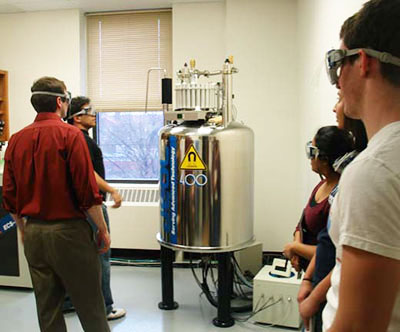 The largest of the new instruments is a Nuclear Magnetic Resonance Spectrometer. The instrument, which everyone refers to as the "NMR", is a JEOL ECS 400.
The largest of the new instruments is a Nuclear Magnetic Resonance Spectrometer. The instrument, which everyone refers to as the "NMR", is a JEOL ECS 400.
An NMR is commonly used in determining chemical structures, understanding chemical and enzyme kinetics, determining protein structures, and in a variety of other chemical, physical, and biological applications. It is the standard tool for chemical characterization in industry, academics, and government.
An NMR works on the same principles as MRI (magnetic resonance imaging) through exciting atoms to understand their unique environment. The spectrometer is a complex system which, at its core, utilizes a superconducting magnet kept at -459 degrees F through cooling with liquid helium and liquid nitrogen. Our 400 MHz high field NMR is ahead of research standards (for now), has automation power to run countless experiments on 24 different samples in succession, and uses a revolutionary software called Delta which is user-friendly even for beginners.
For a chemistry major at St. Bonaventure, training on the NMR begins as a sophomore in Organic Chemistry I (CHEM 301 & CHML 301). In the photo above, Organic Chemistry students are instructed on the use of the NMR. After training, students use the instrument themselves, at times without direct supervision. Extensive use of the NMR continues in Physical Chemistry II (CHEM 402 & CHML 402) as well as Instrumental Analysis (CHEM 431 & CHML 431). It also finds frequent use in the ongoing research by the Chemistry Department faculty.
Multimode Quad-Core Xeon-Based Server Computer
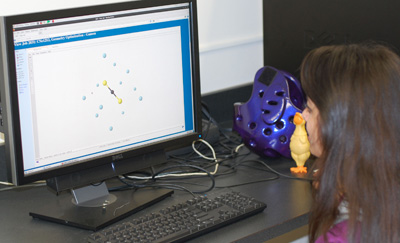 This computer cluster is equipped with Spartan Computational Modeling Software to perform various types of computational chemistry such as molecular mechanics, semi-empirical, ab initio, and density functional theory calculations.
This computer cluster is equipped with Spartan Computational Modeling Software to perform various types of computational chemistry such as molecular mechanics, semi-empirical, ab initio, and density functional theory calculations.
Computational chemistry is a growing field of theoretical chemistry that has a variety of applications such as “docking” of potential drugs into enzyme active sites.
In the photo, a student runs a computation as part of her mentored research.
Glove Box
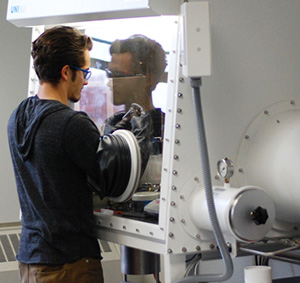 Our MBraun Unilab Glove Box was installed in 2012 and allows for our faculty and student researchers to work in atmospheres free of oxygen for highly unstable materials and complexes.
Our MBraun Unilab Glove Box was installed in 2012 and allows for our faculty and student researchers to work in atmospheres free of oxygen for highly unstable materials and complexes.
Dr. Brestensky uses the glove box in her research with metal complexes.
In the photo to the right, a student works in the Glove Box preparing for an upcoming reaction.
Fluorimeter
The Olis ArcOptix fluorimeter measures the fluorescence emissions of given substances and chemical compounds at seven different wavelengths.
When a molecule is excited with light, sometimes the molecule will emit a different wavelength of light. This is fluorescence and a fluorimeter can quantify this light emission. Applications are found in medicine, biochemistry, and forensics.
Raman Spectrophotometer
The DeltaNu Raman spectrometer is used to observe vibrational, rotational, and other low frequency modes of excitation and is complementary to our infrared spectrometer. Raman is commonly used for analysis of crystals to determine morphology and packing. It is also used in the monitoring of anesthetics during surgery and in the field of nanotechnology for analyzing nanostructures such as nanocrystals, nanotubes, and graphene.
FT- Infrared Spectrophotometer
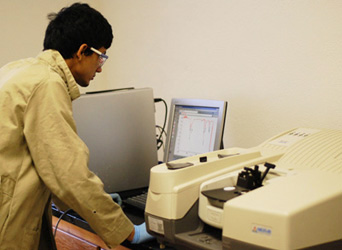 Our Nicolet Nexus 670 FT-IR allows us to excite specific chemical bonds to determine structure or identify compounds by their characteristic IR “fingerprint”. Our instrument also allows for ATR sampling which results in very simple sample preparation.
Our Nicolet Nexus 670 FT-IR allows us to excite specific chemical bonds to determine structure or identify compounds by their characteristic IR “fingerprint”. Our instrument also allows for ATR sampling which results in very simple sample preparation.
Students can expect to work on this instrument by their sophomore year. It is often used in manufacturing for quality control, in plastics analysis, and in forensics, such as to measure blood alcohol content.
In the photo to the right, a student runs an IR sample.
Liquid Chromatography Mass Spectrometer
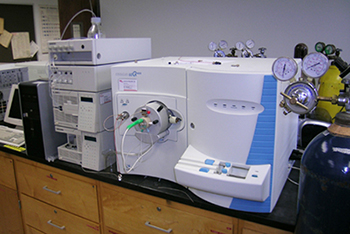 The Liquid Chromatography Mass Spectrometer is a powerful instrument that combines the physical separation capabilities of high performance liquid chromatography (HPLC) with the mass analysis capabilities of mass spectrometry.
The Liquid Chromatography Mass Spectrometer is a powerful instrument that combines the physical separation capabilities of high performance liquid chromatography (HPLC) with the mass analysis capabilities of mass spectrometry.
The LC-MS is standard equipment in the pharmaceutical and chemical industry. It's important in quality control, drug development, as well as testing the pharmacokinetics of drugs to see how quickly it is cleared from the body. It has also been used extensively in proteomics, the follow-up field of study to the sequencing of the human genome.
Gas Chromatography Mass Spectrometer
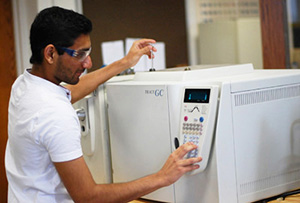 The Liquid Chromatography Mass Spectrometer, described above, complements our previously-obtained Gas Chromatography Mass Spectrometer.
The Liquid Chromatography Mass Spectrometer, described above, complements our previously-obtained Gas Chromatography Mass Spectrometer.
The GC-MS is very important in identifying substances in environmental chemistry, forensics, astro-chemistry, food analysis, and medicine.
In the photo, a student tests a sample on the GC-MS.
Ultraviolet-Visible Spectrophotometer
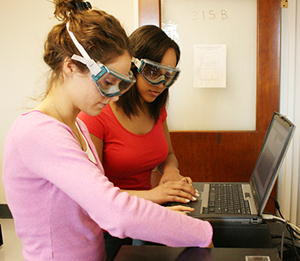 The Ultraviolet-Visible Spectrophotometer measures the ability of molecules to absorb light photons at a particular wavelength in the ultraviolet or visible region.
The Ultraviolet-Visible Spectrophotometer measures the ability of molecules to absorb light photons at a particular wavelength in the ultraviolet or visible region.
The UV-Vis is often used to measure oxidation states of metals, conjugation in organic molecules, and charge transfer between two or more different molecules.
In the photo, chemistry students place a sample in the UV-Vis.